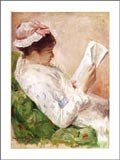 Mary Cassatt is one of my guiding angels. Her paintings of women writing letters, drinking tea, reading, and doing needlework illuminate a life I often imagine for myself - a life surrounded by quiet beauty and the leisure to appreciate it.
Mary Cassatt is one of my guiding angels. Her paintings of women writing letters, drinking tea, reading, and doing needlework illuminate a life I often imagine for myself - a life surrounded by quiet beauty and the leisure to appreciate it.Harriet Scott Chessman, the author of Lydia Cassatt Reading the Morning Papers, has gone beyond the escapist dream by bringing the reader into the life of Lydia Cassatt, the frail older sister who posed for many of Mary Cassatt's best-known paintings. "I have thought, imagined, and dreamt my way into her world," says the author. The narrative wanders as Lydia poses, musing as she holds up a teacup for hours or reads a newspaper. Lydia remembers the young man she once loved, the images she saw through her dead brother's telescope, the great artists she has known (Degas, Pissarro, Renoir), and her mother's sense of betrayal when Mary sells portraits of family members.
"Who is going to care about such pictures as much as Mary's own family?" asks Mother Cassatt. Lydia understands the core of Mary's art - how she works for hours to capture the image, gesture, and illumination of one moment, how beloved and iconic these paintings will become.
Lydia does not always understand what Mary sees, and especially not what Mary see is her, but she cherishes the gift that her sister has given her by using her image as the public face of Mary's genius.
Mary Cassatt creates the five paintings that comprise the narrative after Lydia is diagnosed with Bright's disease, inevitably fatal in the nineteenth century. Lydia's disease, her helplessness and agony, often delays the progression of the paintings. It does not affect the bond between Lydia and her sister, whose love and care seem to bathe Lydia's suffering in the rosy, caressing light in the portraits. Even Degas, whose brusque and sarcastic manner often upsets Mary, seems to become a more caring, softer presence as Lydia's life ebbs.
Chessman portrays the details of Lydia's disease and decline in prose quite blunt. One does not have to imagine the pain or embarassment of these symptoms; the prose leaves little room for imagination. However, Lydia is neither diminished by her disease nor severed from her essence. She retains the ability to observe, analyze, and understand her sister's vision and her own joy to have been a part of Mary's art.
At the end of her life, Lydia's deepest imaginings buoy her: "To live in that world you made... that creamy world of no difficulty, no blood... a life like a shell curling in on itself, glistening and clean on the sand, rolled in salt water, rolled and rolled, spent and spending." This book allows the reader to bask in both worlds - the world illumined by the magic captor of light, and the world in which we observe the mundane details behind the illusion.
Chessman has written a seamless and welcome glimpse of these worlds. Don't miss it.


No comments:
Post a Comment